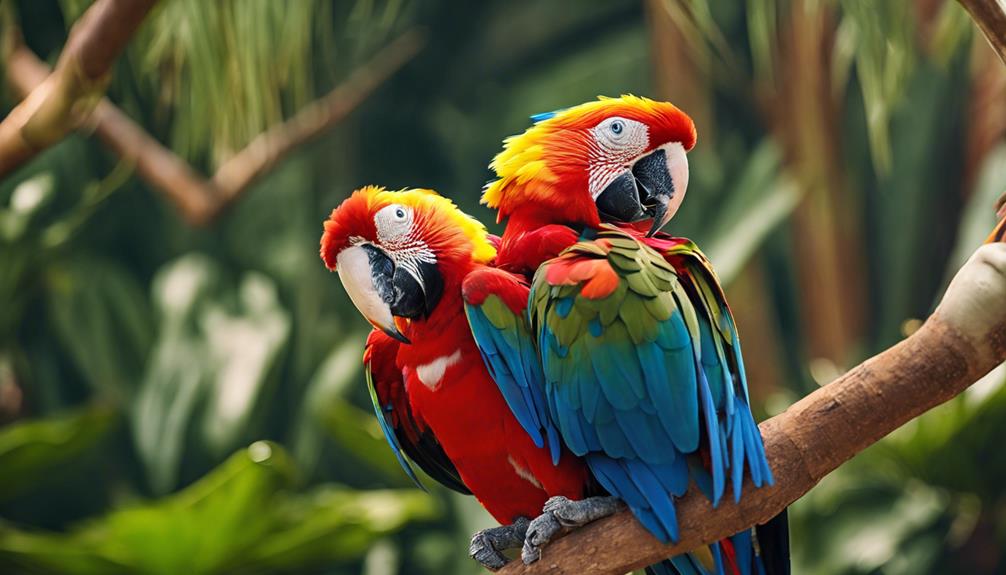In our search for the best exotic bird breeders in Arizona, we have come across several reputable options. The Arizona Bird Store excels in providing high-quality birds and valuable guidance. Birds, and Then Some offers a diverse selection of pet birds with a strong focus on health and well-being. Pretty Feathers Bird Store offers top-notch care for its feathered residents and sells quality bird-related products. AZ Exotic Bird Rescue is committed to rescuing and rehoming exotic birds while promoting responsible ownership. Lastly, Birdz & Beyond is known for its outstanding bird care services and spacious facility.
Explore these top breeders for a fulfilling experience in avian companionship.
Key Takeaways
- Arizona Bird Store: Reputable breeder with diverse exotic birds.
- Birds, and Then Some: One-stop destination for exotic bird lovers.
- Pretty Feathers Bird Store: Premium care for exotic birds.
- AZ Exotic Bird Rescue, Inc: Rescues and rehomes exotic birds responsibly.
- Birdz & Beyond: Renowned for exceptional care and variety of exotic birds.
Arizona Bird Store
Located in Mesa, Arizona, the Arizona Bird Store stands out as a reputable and top-tier bird breeder known for its exceptional quality birds and services. The store offers a diverse selection of pet birds, ranging from colorful parrots to melodious canaries, catering to the preferences of bird enthusiasts. The Arizona Bird Store prides itself on providing a wide array of pet bird options, ensuring that customers can find the perfect feathered companion to suit their lifestyle and needs.
With a focus on bird health and well-being, the Arizona Bird Store sets itself apart as a trusted source for high-quality birds and bird-related products in Mesa, Arizona. The knowledgeable staff at the store is dedicated to assisting customers in selecting the ideal pet bird and offering valuable advice on bird care and maintenance. Whether you're a seasoned bird owner or a first-time bird enthusiast, the Arizona Bird Store is committed to providing a welcoming and informative environment for all pet bird lovers.
Birds, and Then Some

At Birds, and Then Some in Phoenix, Arizona, visitors can expect a diverse array of pet birds and all-encompassing bird-related products and services. This establishment, located at 16026 N 32nd St, is a hub for bird enthusiasts in the United States. Their reputation for excellence stems from the quality guidance provided by their knowledgeable staff on bird care, ensuring the health and well-being of all their birds. Customers can contact them at +1 602-548-0133 or visit their website at [Birds, and Then Some Facebook page](https://www.facebook.com/birdsandthensome) for more information.
| Services | Products |
|---|---|
| Bird Boarding | Cages |
| Grooming | Toys |
| Veterinary Care | Food & Treats |
| Behavioral Training | Accessories |
The diverse selection of pet birds coupled with a wide range of bird-related products and services makes Birds, and Then Some a one-stop destination for all bird lovers in Phoenix, Arizona.
Pretty Feathers Bird Store
Nestled in Apache Junction, Arizona, Pretty Feathers Bird Store stands as a reputable establishment offering a diverse selection of birds and high-quality bird-related products.
At Pretty Feathers Bird Store, bird enthusiasts can find a wide range of exotic birds, from colorful parrots to melodious canaries. The store prides itself on providing excellent care for all their feathered residents, making sure they're healthy and well-socialized.
In addition to live birds, Pretty Feathers Bird Store also offers an array of premium bird-related products, including nutritious bird food, spacious cages, and engaging toys to keep pet birds happy and stimulated.
- Variety of Birds: Pretty Feathers Bird Store offers a diverse selection of exotic birds.
- Quality Care: The store focuses on providing excellent care for all their feathered residents.
- Premium Products: Customers can find high-quality bird-related products like nutritious bird food and engaging toys.
- Healthy Birds: Pretty Feathers Bird Store makes sure that all their birds are healthy and well-socialized.
AZ Exotic Bird Rescue, Inc

AZ Exotic Bird Rescue, Inc., situated on N Scottsdale Rd in Scottsdale, AZ, actively engages in rescuing and rehoming a variety of exotic birds, emphasizing education and adoption programs. The organization's dedication to bird welfare is evident in their successful facilitation of over 200 bird adoptions, ensuring these beautiful creatures find loving homes. They offer an adoption program that allows individuals to provide a forever home for rescued birds, emphasizing the importance of responsible pet ownership. Additionally, AZ Exotic Bird Rescue, Inc. conducts educational workshops on bird care, equipping bird owners with the knowledge and skills needed to provide excellent care for their feathered companions.
| Services Provided | Details |
|---|---|
| Adoption Program | Facilitated over 200 adoptions |
| Educational Workshops | Focus on bird care |
| Rescue Efforts | Rehoming exotic birds |
Birdz & Beyond

Located in Phoenix, Arizona, Birdz & Beyond offers a diverse selection of exotic birds and related products, known for its exceptional bird care services and high-quality products. The facility at 3519 W Thunderbird Rd is large enough to accommodate various bird species comfortably.
Here are some key features of Birdz & Beyond:
- Quality Care: Birdz & Beyond is renowned for its exceptional bird care services, ensuring that all birds are healthy and well looked after.
- Variety of Exotic Birds: The establishment offers a wide range of exotic birds, allowing customers to choose from various species.
- High-Quality Products: Birdz & Beyond not only provides birds but also offers premium products for bird care and maintenance.
- Room to Move Around: The spacious environment at Birdz & Beyond allows birds to move around freely, promoting their physical well-being.
Visit Birdz & Beyond at 3519 W Thunderbird Rd or contact them at +1 602-993-4700 to experience their exceptional services firsthand. Follow them on Instagram at [Birdz & Beyond](https://www.instagram.com/birdzandbeyond/) for more insights into their offerings.
Frequently Asked Questions
What Kind of Bird Is Green With an Orange Head in Arizona?
We believe the bird described as green with an orange head in Arizona is likely the Mitred Conure, a striking parrot species. These medium-sized birds from South America are popular for their vibrant colors and friendly, social behavior.
How Did Love Birds Get to Arizona?
Love birds were introduced to Arizona as exotic pets, arriving through pet trade channels and breeding programs. Their vibrant colors and playful nature made them popular choices. Arizona's warm climate and suitable habitat conditions support the breeding and maintenance of love birds.
Are Peach Faced Lovebirds in Arizona?
Yes, Peach Faced Lovebirds are in Arizona. They thrive in the warm climate and can be found in urban areas, parks, and gardens. Their vibrant colors and social nature make them popular among bird enthusiasts for their beauty and playful personalities.
Are Rosy-Faced Lovebirds Native to Arizona?
No, rosy-faced lovebirds are not native to Arizona. Indigenous to southwestern Africa, they have become popular pets in the U.S. Although not found in the Arizona wild, understanding their natural habitat is essential for care and conservation efforts.
Are Exotic Bird Breeders in Ohio as Reputable as Those in Arizona?
When it comes to finding top bird breeders, Ohio boasts a reputable selection. However, Arizona is also home to top bird breeders known for their expertise and high-quality birds. Whether in Ohio or Arizona, it’s crucial to thoroughly research and visit breeders before making a purchase.
Conclusion
To sum up, the top 5 exotic bird breeders in Arizona offer a diverse range of species for bird enthusiasts. Each breeder provides expert care and knowledge to guarantee the well-being of their feathered friends.
As we spread our wings and explore the world of exotic birds, let's remember that every bird is as unique as a rare gem, waiting to be discovered and cherished.
Fly high and embrace the beauty of these magnificent creatures.










